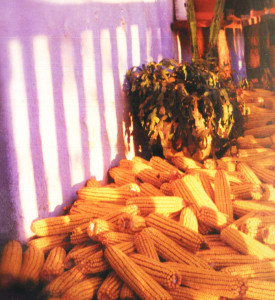
 In the olden times, there were no great opportunities for boys and girls to meet. During the week particularly the girls hardly left the house or the house yard except to attend mass; everyday chores were tough enough for girls and boys alike, so there was no spare time for chatting.
In the olden times, there were no great opportunities for boys and girls to meet. During the week particularly the girls hardly left the house or the house yard except to attend mass; everyday chores were tough enough for girls and boys alike, so there was no spare time for chatting.
The only chances for young boys and girls to socialize were after mass, at Sunday’s dance, for the Easter time walk and during communal work, when neighbours gathered to accomplish certain tasks (wheat threshing, flax fibre manufacturing, maize husking, etc.). Once the job was finished, a celebration was usually hosted.
The process of removing the outer layers of the maize ear leaving only the cob or seed rack, artazuriketa, was a seasonal task in every farmhouse. People, mostly from the neighbourhood, participated in the social event; the higher the pile of maize to be husked, the bigger the crowd assembled, occasionally a multitude of up to forty volunteers, old and young, all in good harmony.
Maize husking was a task generally carried out late in the afternoon or the evening, when the rest of the farm chores had been accomplished. In order to make the task more enjoyable, the atmosphere would slowly warm up, and the youth would engage in singing and bertso making. In Nafarroa the songs were called arrosnabarrak; they were joyful and festive compositions on the amusing topic of boys and girls matchmaking. Sometimes the referred characters were real, but often true and fictitious stories intertwined leading to humorous situations: a charming young girl coupled with an old man or a man with a physical imperfection…
Verses were improvised based upon old traditional songs that everybody knew changing the names of the houses and the characters. Here we have an example.


